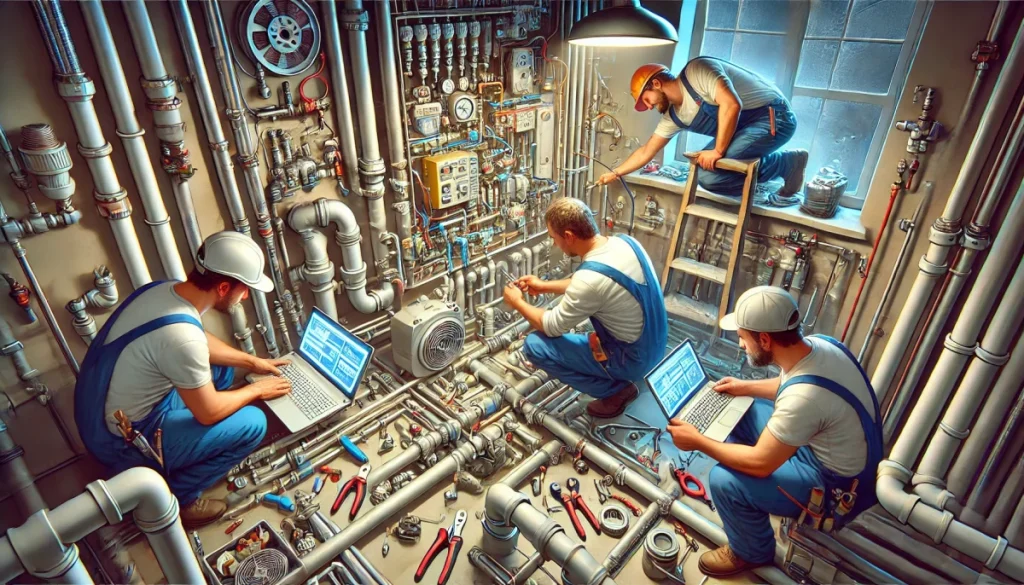Appropriate materials selection and the implementation of correct installation techniques are paramount in ensuring the safety, efficiency, and longevity of gas line systems. Improper choices in these critical areas can lead to severe consequences, compromising not only the integrity of the installation but also the safety of building occupants. This section will elucidate the importance of proper material selection and installation techniques, outline potential risks associated with improper practices, and provide comprehensive guidelines for ensuring compliance with industry standards.
Significance of Proper Material Selection
The choice of materials for gas line installations is a decision of utmost importance, with far-reaching implications for system performance and safety:
- Compatibility with Gas Type: Different gases may require specific materials to ensure chemical compatibility and prevent degradation over time. For instance, materials suitable for natural gas may not be appropriate for propane installations.
- Pressure Ratings: Selected materials must be capable of withstanding the maximum operating pressures of the gas system, including potential pressure fluctuations.
- Environmental Factors: Consideration must be given to environmental conditions such as temperature extremes, humidity, and exposure to corrosive elements that may affect material integrity.
- Regulatory Compliance: Materials must meet or exceed the standards set forth by regulatory bodies and industry guidelines to ensure legal compliance and insurance validity.
Consequences of Improper Material Selection
The use of unsuitable materials in gas line installations can result in severe repercussions:
- Gas Leaks: Incompatible or substandard materials may deteriorate prematurely, leading to gas leaks that pose significant safety risks.
- System Failures: Materials that cannot withstand operating pressures or environmental conditions may fail catastrophically, causing system shutdowns or dangerous ruptures.
- Increased Maintenance Costs: Improper materials often require more frequent inspections, repairs, and replacements, escalating long-term operational costs.
- Legal and Financial Liabilities: Non-compliant materials can lead to violations of building codes and safety regulations, resulting in fines, legal actions, and potential loss of insurance coverage.
Importance of Correct Installation Techniques
Proper installation techniques are equally critical in ensuring the safety and efficiency of gas line systems:
- Leak Prevention: Correct installation methods, including proper sealing and connection techniques, are essential for preventing gas leaks.
- System Integrity: Proper installation ensures that the gas line system maintains its structural integrity under various operating conditions and over extended periods.
- Operational Efficiency: Correctly installed systems operate at optimal efficiency, reducing energy waste and operational costs.
- Compliance with Standards: Adherence to proper installation techniques is often mandated by building codes and industry standards.
Risks Associated with Improper Installation Techniques
The implementation of incorrect installation techniques can lead to numerous hazards:
- Immediate Safety Hazards: Improperly installed gas lines may leak immediately upon activation, creating immediate fire or explosion risks.
- Long-term Degradation: Incorrect installation can lead to gradual system deterioration, potentially resulting in future failures or leaks.
- Performance Issues: Improper techniques may result in pressure losses, inadequate gas flow, or inconsistent appliance operation.
- Regulatory Non-compliance: Installations that do not adhere to prescribed techniques may fail inspections, leading to project delays and additional costs.
Best Practices for Material Selection and Installation
To mitigate risks associated with improper materials and installation techniques, the following best practices should be meticulously observed:
- Comprehensive Material Evaluation: Conduct thorough assessments of material properties, including pressure ratings, chemical compatibility, and environmental resistance, before selection.
- Adherence to Industry Standards: Utilize only materials and installation techniques that comply with relevant industry standards and local regulations.
- Professional Installation: Engage certified professionals with specific expertise in gas line installations to ensure proper techniques are employed.
- Quality Control Measures: Implement rigorous quality control processes, including material inspections and installation audits, to verify compliance with specifications.
- Documentation and Traceability: Maintain detailed records of material specifications, sourcing, and installation procedures for future reference and compliance verification.
- Ongoing Training: Ensure that installation personnel receive regular training on the latest materials, techniques, and safety protocols in gas line installations.
- Proper Tools and Equipment: Utilize specialized tools and equipment designed for gas line installations to ensure precision and consistency in the installation process.
In conclusion, the use of proper materials and installation techniques is fundamental to the safety, efficiency, and reliability of gas line systems. By prioritizing these critical aspects, stakeholders can significantly reduce the risks associated with gas line installations and ensure long-term system integrity. The investment in high-quality materials and professional installation practices is not merely a regulatory obligation but a fundamental responsibility to ensure the safety of building occupants and the longevity of the gas distribution system.
It is imperative that all parties involved in gas line installations—from project managers to field technicians—recognize the critical nature of proper material selection and installation techniques. By fostering a culture of excellence in these areas, the industry can continue to improve safety standards and operational efficiencies in gas line installations, ultimately benefiting all stakeholders in the built environment.



